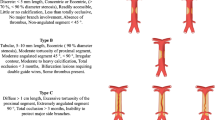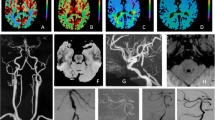Abstract
Purpose
Two recent randomized controlled trials (RCT) consistently showed superiority of aggressive medical treatment versus percutaneous transluminal angioplasty and stenting (PTAS) in patients with intracranial artery stenosis. Patients with symptomatic basilar stenosis have a higher long-term risk of recurrent stroke compared to patients with anterior circulation stenosis but no study has specifically focused on the role of PTAS in this subgroup. The aim of our study was to investigate the subgroup of patients with symptomatic basilar artery stenosis to find evidence for the feasibility of a future clinical trial.
Methods
Patients with ischemic stroke caused by a symptomatic basilar stenosis and admitted to five German tertiary care hospitals were included in this multicenter effectiveness study. Primary outcome was a composite endpoint of stroke recurrence, clinically relevant restenosis, progression and death. Shared frailty Cox regression models were used to compare outcome rates between groups.
Results
Of the 139 patients included in the study 79 (57 %) underwent PTAS and 60 (43 %) conservative treatment alone. The median follow-up period was 300 (IQR 18–738) days. Risks of the primary composite outcome (hazard ratio HR 0.49, 95 % confidence interval CI 0.25–0.97, p = 0.039) and of the key secondary outcomes recurrent stroke (HR 0.42, 95 % CI 0.19–0.95, p = 0.037) and clinically relevant restenosis/progression (HR 0.12, 95 % CI 0.03–0.59, p = 0.009) were lower in patients with PTAS compared to conservative treatment. There was no difference in all-cause mortality between groups (HR 0.98, 95 % CI 0.19–5.09, p = 0.979).
Conclusion
In this retrospective study we could not reproduce the findings from large RCTs on intracranial stenting. Our data could be considered as a basis for a prospective study on patient selection for PTAS in the basilar artery.


Similar content being viewed by others
References
Wehman JC, Hanel RA, Guidot CA, Guterman LR, Hopkins LN. Atherosclerotic occlusive extracraneal vertebral artery disease: indications for intervention, endovascular techniques, short term and long term results. J Interv Cardiol. 2004;17:219–32.
Cloud GC, Markus HS. Diagnosis and management of vertebral artery stenosis. QJM. 2003;96:27–54.
Caplan LR, Wityk RJ, Glass TA, Tapia J, Pazdera L, Chang HM, et al. New England medical center posterior circulation registry. Ann Neurol. 2004;56:289–98.
Marquardt L, Kuker W, Chandratheva A, Geraghty O, Rothwell PM. Incidence and prognosis of 〉 or = 50 % symptomatic vertebral or basilar artery stenosis: prospective population-based study. Brain. 2009;132:982–8.
Flossmann E, Rothwell PM. Prognosis of vertebrobasilar transient ischaemic attack and minor stroke. Brain. 2003;126:1940–54.
Gulli G, Khan S, Markus HS. Vertebrobasilar stenosis predicts high early recurrent stroke risk in posterior circulation stroke and TIA. Stroke. 2009;40:2732–7.
Chimowitz MI, Lynn MJ, Howlett-Smith H, Stern BJ, Hertzberg VS, Frankel MR, Levine SR, Chaturvedi S, Kasner SE, Benesch CG, Sila CA, Jovin TG, Romano JG; Warfarin-Aspirin Symptomatic Intracranial Disease Trial Investigators. Comparison of warfarin and aspirin for symptomatic intracranial arterial stenosis. N Engl J Med. 2005;352:1305–16.
Qureshi AI, Ziai WC, Yahia AM, Mohammad Y, Sen S, Agarwal P, Zaidat OO, Suarez JI, Wityk RJ. Stroke-free survival and its determinants in patients with symptomatic vertebrobasilar stenosis: a multicenter study. Neurosurgery. 2003;52:1033–9.
Yu W, Smith WS, Singh V, Ko NU, Cullen SP, Dowd CF, Halbach VV, Higashida RT. Long-term outcome of endovascular stenting for symptomatic basilar artery stenosis. Neurology. 2005;64:1055–7.
Jiang WJ, Du B, Hon SF, Jin M, Xu XT, Ma N, Gao F, Dong KH. Do patients with basilar or vertebral artery stenosis have a higher stroke incidence poststenting? J Neurointerv Surg. 2010;2:50–4.
Chimowitz MI, Lynn MJ, Derdeyn CP, Turan TN, Fiorella D, Lane BF, Janis LS, Lutsep HL, Barnwell SL, Waters MF, Hoh BL, Hourihane JM, Levy EI, Alexandrov AV, Harrigan MR, Chiu D, Klucznik RP, Clark JM, McDougall CG, Johnson MD, Pride GL Jr, Torbey MT, Zaidat OO, Rumboldt Z, Cloft HJ; SAMMPRIS Trial Investigators. Stenting versus aggressive medical therapy for intracranial arterial stenosis. N Engl J Med. 2011;365:993–1003.
Zaidat OO, Fitzsimmons BF, Woodward BK, Wang Z, Killer-Oberpfalzer M, Wakhloo A, Gupta R, Kirshner H, Megerian JT, Lesko J, Pitzer P, Ramos J, Castonguay AC, Barnwell S, Smith WS, Gress DR; VISSIT Trial Investigators. Effect of a balloon-expandable intracranial stent vs medical therapy on risk of stroke in patients with symptomatic intracranial stenosis the VISSIT randomized clinical trial. JAMA. 2015;313:1240–8.
Sheikh BY, Ezura M, Takahashi A, Yoshimoto T. Basilar artery percutaneous transluminal angioplasty. Technique and results. Interv Neuroradiol. 2000;30(6 Suppl 1):155–8.
Derdeyn CP, Chimowitz MI, Lynn MJ, Fiorella D, Turan TN, Janis LS, Montgomery J, Nizam A, Lane BF, Lutsep HL, Barnwell SL, Waters MF, Hoh BL, Hourihane JM, Levy EI, Alexandrov AV, Harrigan MR, Chiu D, Klucznik RP, Clark JM, McDougall CG, Johnson MD, Pride GL Jr, Lynch JR, Zaidat OO, Rumboldt Z, Cloft HJ; Stenting and Aggressive Medical Management for Preventing Recurrent Stroke in Intracranial Stenosis Trial Investigators. Aggressive medical treatment with or without stenting in high-risk patients with intracranial artery stenosis (SAMMPRIS): the final results of a randomised trial. Lancet. 2014;383:333–41.
Chimowitz MI, Lynn MJ, Turan TN, Fiorella D, Lane BF, Janis S, Derdeyn CP; SAMMPRIS Investigators. Design of the stenting and aggressive medical management for preventing recurrent stroke in intracranial stenosis trial. J Stroke Cerebrovasc Dis. 2011;20:357–68.
Abuzinadah AR, Alanazy MH, Almekhlafi MA, Duan Y, Zhu H, Mazighi M, Lutsep HL, Donnon T, Hill MD. Stroke recurrence rates among patients with symptomatic intracranial vertebrobasilar stenoses: systematic review and meta-analysis. J Neurointerv Surg. 2016;8(2):112–6.
Author information
Authors and Affiliations
Corresponding authors
Ethics declarations
Conflict of interests
I.L. Maier, A. Karch, C. Lipke, D. Behme, A. Mpotsaris, C. Kabbasch, T. Liebig, A. Faymonville, A. Reich, O. Nikoubashman, P. von Schoenfeld, W. Weber, M. Bähr, M. Knauth, K. Kallenberg, and J. Liman state that they have no conflict of interests. J.-H. Buhk received remuneration as a consultant for DePuy Codman. R.T. Mikolajczyk was involved in studies funded by Bayer Pharma AG while working for his previous employer.
Ethical standards
This article does not contain any studies with human participants or animals performed by any of the authors. Confirmation was received from the responsible ethics committee that approval was not necessary due to the nature of the study.
Additional information
Author contributions
Kai Kallenberg and Jan Liman contributed equally to the study.
Caption Electronic Supplementary Material
Rights and permissions
About this article
Cite this article
Maier, I.L., Karch, A., Lipke, C. et al. Transluminal angioplasty and stenting versus conservative treatment in patients with symptomatic basilar artery stenosis. Clin Neuroradiol 28, 33–38 (2018). https://doi.org/10.1007/s00062-016-0528-x
Received:
Accepted:
Published:
Issue Date:
DOI: https://doi.org/10.1007/s00062-016-0528-x




